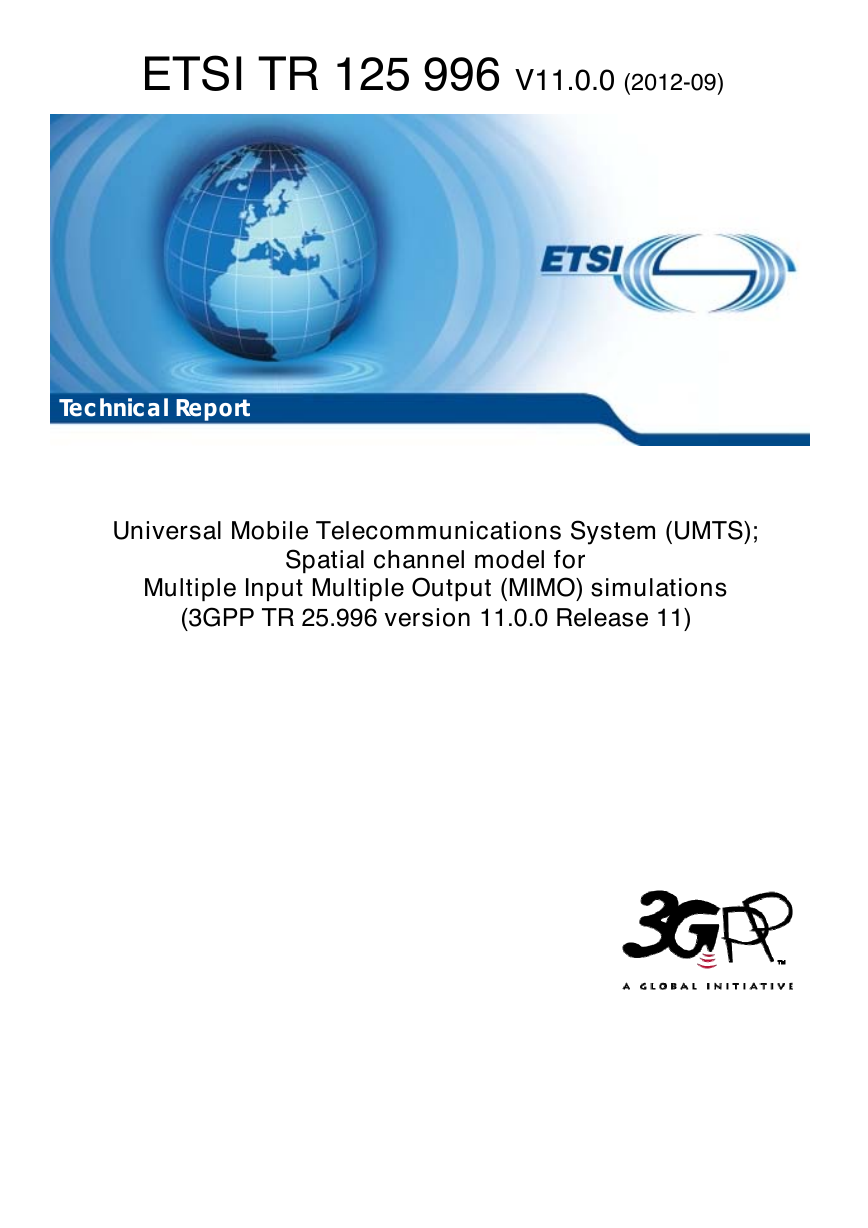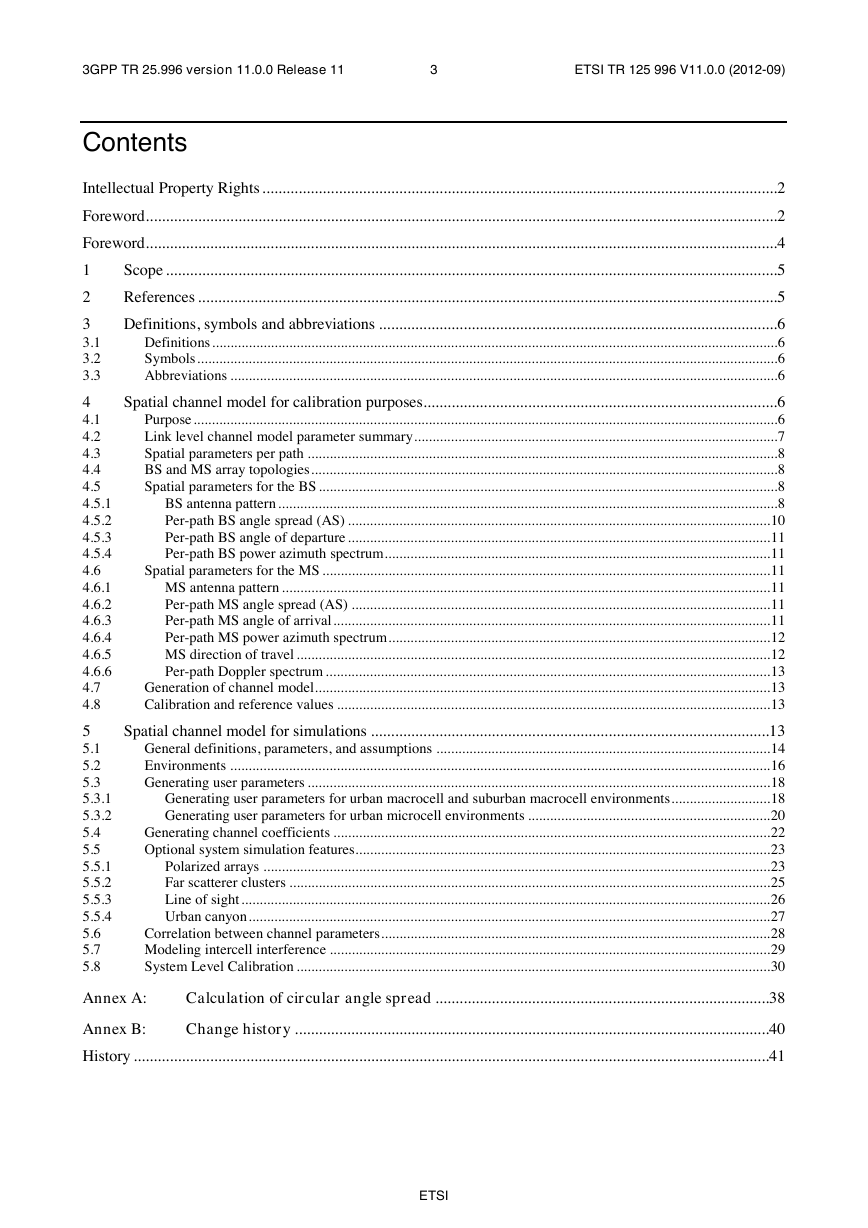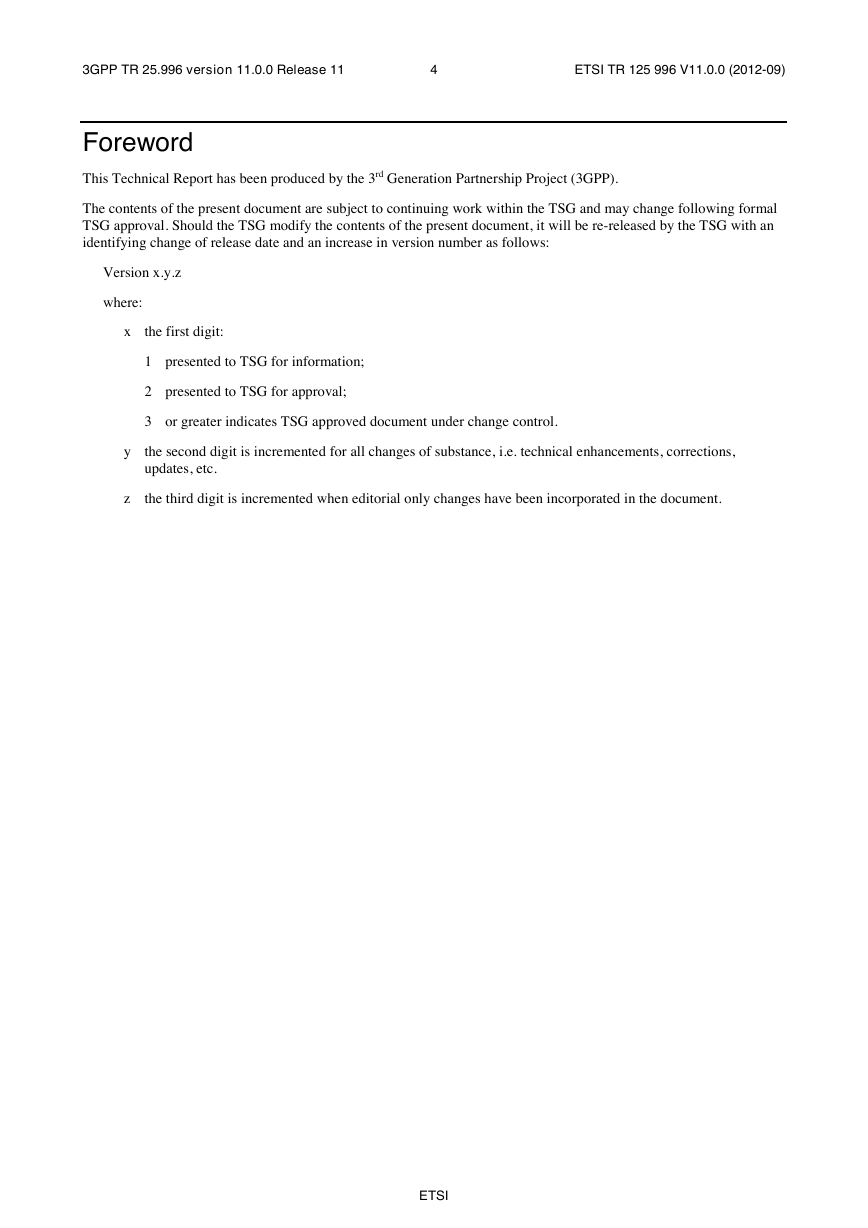ETSI TR 125 996 V11.0.0 (2012-09)
Technical Report
Universal Mobile Telecommunications System (UMTS);
Spatial channel model for
Multiple Input Multiple Output (MIMO) simulations
(3GPP TR 25.996 version 11.0.0 Release 11)
�
3GPP TR 25.996 version 11.0.0 Release 11
1
ETSI TR 125 996 V11.0.0 (2012-09)
Reference
RTR/TSGR-0125996vb00
Keywords
UMTS
ETSI
650 Route des Lucioles
F-06921 Sophia Antipolis Cedex - FRANCE
Tel.: +33 4 92 94 42 00 Fax: +33 4 93 65 47 16
Siret N° 348 623 562 00017 - NAF 742 C
Association à but non lucratif enregistrée à la
Sous-Préfecture de Grasse (06) N° 7803/88
Important notice
Individual copies of the present document can be downloaded from:
http://www.etsi.org
The present document may be made available in more than one electronic version or in print. In any case of existing or
perceived difference in contents between such versions, the reference version is the Portable Document Format (PDF).
In case of dispute, the reference shall be the printing on ETSI printers of the PDF version kept on a specific network drive
within ETSI Secretariat.
Users of the present document should be aware that the document may be subject to revision or change of status.
Information on the current status of this and other ETSI documents is available at
http://portal.etsi.org/tb/status/status.asp
If you find errors in the present document, please send your comment to one of the following services:
http://portal.etsi.org/chaircor/ETSI_support.asp
Copyright Notification
No part may be reproduced except as authorized by written permission.
The copyright and the foregoing restriction extend to reproduction in all media.
© European Telecommunications Standards Institute 2012.
All rights reserved.
DECTTM, PLUGTESTSTM, UMTSTM and the ETSI logo are Trade Marks of ETSI registered for the benefit of its Members.
3GPPTM and LTE™ are Trade Marks of ETSI registered for the benefit of its Members and
GSM® and the GSM logo are Trade Marks registered and owned by the GSM Association.
of the 3GPP Organizational Partners.
ETSI
�
3GPP TR 25.996 version 11.0.0 Release 11
2
ETSI TR 125 996 V11.0.0 (2012-09)
Intellectual Property Rights
IPRs essential or potentially essential to the present document may have been declared to ETSI. The information
pertaining to these essential IPRs, if any, is publicly available for ETSI members and non-members, and can be found
in ETSI SR 000 314: "Intellectual Property Rights (IPRs); Essential, or potentially Essential, IPRs notified to ETSI in
respect of ETSI standards", which is available from the ETSI Secretariat. Latest updates are available on the ETSI Web
server (http://ipr.etsi.org).
Pursuant to the ETSI IPR Policy, no investigation, including IPR searches, has been carried out by ETSI. No guarantee
can be given as to the existence of other IPRs not referenced in ETSI SR 000 314 (or the updates on the ETSI Web
server) which are, or may be, or may become, essential to the present document.
Foreword
This Technical Report (TR) has been produced by ETSI 3rd Generation Partnership Project (3GPP).
The present document may refer to technical specifications or reports using their 3GPP identities, UMTS identities or
GSM identities. These should be interpreted as being references to the corresponding ETSI deliverables.
The cross reference between GSM, UMTS, 3GPP and ETSI identities can be found under
http://webapp.etsi.org/key/queryform.asp.
ETSI
�
3GPP TR 25.996 version 11.0.0 Release 11
3
ETSI TR 125 996 V11.0.0 (2012-09)
Contents
Intellectual Property Rights ................................................................................................................................ 2
Foreword ............................................................................................................................................................. 2
Foreword ............................................................................................................................................................. 4
1
2
3
3.1
3.2
3.3
4
4.1
4.2
4.3
4.4
4.5
4.5.1
4.5.2
4.5.3
4.5.4
4.6
4.6.1
4.6.2
4.6.3
4.6.4
4.6.5
4.6.6
4.7
4.8
5
5.1
5.2
5.3
5.3.1
5.3.2
5.4
5.5
5.5.1
5.5.2
5.5.3
5.5.4
5.6
5.7
5.8
Scope ........................................................................................................................................................ 5
References ................................................................................................................................................ 5
Definitions, symbols and abbreviations ................................................................................................... 6
Definitions .......................................................................................................................................................... 6
Symbols .............................................................................................................................................................. 6
Abbreviations ..................................................................................................................................................... 6
Spatial channel model for calibration purposes ........................................................................................ 6
Purpose ............................................................................................................................................................... 6
Link level channel model parameter summary ................................................................................................... 7
Spatial parameters per path ................................................................................................................................ 8
BS and MS array topologies ............................................................................................................................... 8
Spatial parameters for the BS ............................................................................................................................. 8
BS antenna pattern ........................................................................................................................................ 8
Per-path BS angle spread (AS) ................................................................................................................... 10
Per-path BS angle of departure ................................................................................................................... 11
Per-path BS power azimuth spectrum ......................................................................................................... 11
Spatial parameters for the MS .......................................................................................................................... 11
MS antenna pattern ..................................................................................................................................... 11
Per-path MS angle spread (AS) .................................................................................................................. 11
Per-path MS angle of arrival ....................................................................................................................... 11
Per-path MS power azimuth spectrum ........................................................................................................ 12
MS direction of travel ................................................................................................................................. 12
Per-path Doppler spectrum ......................................................................................................................... 13
Generation of channel model............................................................................................................................ 13
Calibration and reference values ...................................................................................................................... 13
Spatial channel model for simulations ................................................................................................... 13
General definitions, parameters, and assumptions ........................................................................................... 14
Environments ................................................................................................................................................... 16
Generating user parameters .............................................................................................................................. 18
Generating user parameters for urban macrocell and suburban macrocell environments ........................... 18
Generating user parameters for urban microcell environments .................................................................. 20
Generating channel coefficients ....................................................................................................................... 22
Optional system simulation features................................................................................................................. 23
Polarized arrays .......................................................................................................................................... 23
Far scatterer clusters ................................................................................................................................... 25
Line of sight ................................................................................................................................................ 26
Urban canyon .............................................................................................................................................. 27
Correlation between channel parameters .......................................................................................................... 28
Modeling intercell interference ........................................................................................................................ 29
System Level Calibration ................................................................................................................................. 30
Annex A:
Calculation of circular angle spread ................................................................................... 38
Annex B:
Change history ...................................................................................................................... 40
History .............................................................................................................................................................. 41
ETSI
�
3GPP TR 25.996 version 11.0.0 Release 11
4
ETSI TR 125 996 V11.0.0 (2012-09)
Foreword
This Technical Report has been produced by the 3rd Generation Partnership Project (3GPP).
The contents of the present document are subject to continuing work within the TSG and may change following formal
TSG approval. Should the TSG modify the contents of the present document, it will be re-released by the TSG with an
identifying change of release date and an increase in version number as follows:
Version x.y.z
where:
x
the first digit:
1 presented to TSG for information;
2 presented to TSG for approval;
3 or greater indicates TSG approved document under change control.
y
the second digit is incremented for all changes of substance, i.e. technical enhancements, corrections,
updates, etc.
z
the third digit is incremented when editorial only changes have been incorporated in the document.
ETSI
�
3GPP TR 25.996 version 11.0.0 Release 11
5
ETSI TR 125 996 V11.0.0 (2012-09)
Scope
1
The present document details the output of the combined 3GPP-3GPP2 spatial channel model (SCM) ad-hoc group
(AHG).
The scope of the 3GPP-3GPP2 SCM AHG is to develop and specify parameters and methods associated with the spatial
channel modelling that are common to the needs of the 3GPP and 3GPP2 organizations. The scope includes
development of specifications for:
System level evaluation.
Within this category, a list of four focus areas are identified, however the emphasis of the SCM AHG work is on items a
and b.
a) Physical parameters (e.g. power delay profiles, angle spreads, dependencies between parameters)
b) System evaluation methodology.
c) Antenna arrangements, reference cases and definition of minimum requirements.
d) Some framework (air interface) dependent parameters.
Link level evaluation.
The link level models are defined only for calibration purposes. It is a common view within the group that the link level
simulation assumptions will not be used for evaluation and comparison of proposals.
References
2
The following documents contain provisions which, through reference in this text, constitute provisions of the present
document.
• References are either specific (identified by date of publication, edition number, version number, etc.) or
non-specific.
• For a specific reference, subsequent revisions do not apply.
• For a non-specific reference, the latest version applies. In the case of a reference to a 3GPP document
(including a GSM document), a non-specific reference implicitly refers to the latest version of that document in
the same Release as the present document.
[1]
[2]
[3]
H. M. Foster, S. F. Dehghan, R. Steele, J. J. Stefanov, H. K. Strelouhov, Role of Site Shielding in
Prediction Models for Urban Radiowave Propagation (Digest No. 1994/231), IEE Colloquium on
Microcellular measurements and their prediction, 1994 pp. 2/1-2/6 .
L. Greenstein, V. Erceg, Y. S. Yeh, M. V. Clark, “A New Path-Gain/Delay-Spread Propagation
Model for Digital Cellular Channels,” IEEE Transactions on Vehicular Technology, VOL. 46,
NO.2, May 1997, pp.477-485.
L. M. Correia, Wireless Flexible Personalized Communications, COST 259: European Co-
operation in Mobile Radio Research, Chichester: John Wiley & Sons, 2001. Sec. 3.2 (M.
Steinbauer and A. F. Molisch, "Directional channel models").
ETSI
�
3GPP TR 25.996 version 11.0.0 Release 11
6
ETSI TR 125 996 V11.0.0 (2012-09)
3
Definitions, symbols and abbreviations
3.1
Definitions
For the purposes of the present document, the following terms and definitions apply.
Path: Ray
Path Component: Sub-ray
3.2
Symbols
For the purposes of the present document, the following symbols apply:
σ
AS
SF
DS
σ
σ
σ
SH
),( baη
Angle Spread or Azimuth Spread (Note: unless otherwise stated, the calculation of angle spread
will be based on the circular method presented in appendix A)
delay spread
lognormal shadow fading random variable
log normal shadow fading constant
represents a random normal (Gaussian) distribution with mean a and variance b.
3.3
Abbreviations
For the purposes of the present document, the following abbreviations apply:
AHG
AoA
AoD
AS
BS
DoT
DS
MS
PAS
PDP
PL
SCM
SF
SH
UE
Ad Hoc Group
Angle of Arrival
Angle of Departure
Angle Spread = Azimuth Spread =
spread will be based on the circular method presented in appendix A)
Base Station = Node-B = BTS
Direction of Travel
AS
σ
(Note: unless otherwise stated, the calculation of angle
σ
delay spread = DS
Mobile Station = UE = Terminal = Subscriber Unit
Power Azimuth Spectrum
Power Delay Profile
Path Loss
Spacial Channel Model
lognormal shadow fading random variable =
SF
σ
σ
SH
log normal shadow fading constant =
User Equipment = MS
Spatial channel model for calibration purposes
4
This clause describes physical parameters for link level modelling for the purpose of calibration.
4.1
Purpose
Link level simulations alone will not be used for algorithm comparison because they reflect only one snapshot of the
channel behaviour. Furthermore, they do not account for system attributes such as scheduling and HARQ. For these
reasons, link level simulations do not allow any conclusions about the typical behaviour of the system. Only system
ETSI
�
3GPP TR 25.996 version 11.0.0 Release 11
7
ETSI TR 125 996 V11.0.0 (2012-09)
level simulations can achieve that. Therefore this document targets system level simulations for the final algorithm
comparison.
Link level simulations will not be used to compare performance of different algorithms. Rather, they will be used only
for calibration, which is the comparison of performance results from different implementations of a given algorithm.
The description is in the context of a downlink system where the BS transmits to a MS; however the material in this
4.2
Link level channel model parameter summary
The table below summarizes the physical parameters to be used for link level modelling.
Table 4.1: Summary SCM link level parameters for calibration purposes
Case I
Case B
Case II
Case C
Case III
Case D
Case IV
Case A
Model A, D, E
Model C
Model B
Model F
Modified Pedestrian A
1) 4+1 (LOS on, K = 6dB)
2) 4 (LOS off)
1) 0.0
2) -Inf
1) -6.51
2) 0.0
1) -16.21
2) -9.7
1) -25.71
2) –19.2
1) -29.31
2) -22.8
1) 3
2) 30, 120
0
0
110
190
410
Vehicular A
Pedestrian B
Single Path
6
6
1
0
0
0
0,0
-1.0
-9.0
0
310
710
-10.0
-15.0
-20.0
1090
1730
2510
0.0
-0.9
-4.9
-8.0
-7.8
-23.9
200
800
1200
2300
3700
3, 30, 120
3, 30, 120
Reference 0.5λ
1) LOS on: Fixed AoA for
LOS component, remaining
power has 360 degree
uniform PAS.
2) LOS off: PAS with a
Laplacian distribution, RMS
angle spread of 35 degrees
per path
Reference 0.5λ
RMS angle
spread of 35
degrees per path
with a Laplacian
distribution
Or 360 degree
uniform PAS.
Reference 0.5λ
RMS angle spread
of 35 degrees per
path with a
Laplacian
distribution
0
22.5
-22.5
22.5 (LOS component)
67.5 (all other paths)
67.5 (all paths)
22.5 (odd
numbered paths),
-67.5 (even
numbered paths)
0.5λ-spacing or 4λ-spacing or 10λ-spacing
Reference: ULA with
Laplacian distribution with RMS angle spread of
2 degrees or 5 degrees,
per path depending on AoA/AoD
3
N/A
N/A
N/A
N/A
N/A
N/A
Model
Corresponding
3GPP Designator*
Corresponding
3GPP2 Designator*
PDP
# of Paths
)
B
d
(
r
e
w
o
P
h
a
P
e
v
i
t
t
)
s
n
(
y
a
e
D
l
Speed (km/h)
Topology
PAS
l
a
e
R
n
o
i
t
DoT
(degrees)
AoA
(degrees)
Topology
PAS
t
a
S
e
l
i
b
o
M
E
U
/
e
s
a
B
/
B
e
d
o
N
n
o
i
t
a
t
S
NOTE:
AoD/AoA
(degrees)
*Designators correspond to channel models previously proposed in 3GPP and 3GPP2 ad-hoc
groups.
50ο for 2ο RMS angle spread per path
20ο for 5ο RMS angle spread per path
N/A
ETSI
�
















 2023年江西萍乡中考道德与法治真题及答案.doc
2023年江西萍乡中考道德与法治真题及答案.doc 2012年重庆南川中考生物真题及答案.doc
2012年重庆南川中考生物真题及答案.doc 2013年江西师范大学地理学综合及文艺理论基础考研真题.doc
2013年江西师范大学地理学综合及文艺理论基础考研真题.doc 2020年四川甘孜小升初语文真题及答案I卷.doc
2020年四川甘孜小升初语文真题及答案I卷.doc 2020年注册岩土工程师专业基础考试真题及答案.doc
2020年注册岩土工程师专业基础考试真题及答案.doc 2023-2024学年福建省厦门市九年级上学期数学月考试题及答案.doc
2023-2024学年福建省厦门市九年级上学期数学月考试题及答案.doc 2021-2022学年辽宁省沈阳市大东区九年级上学期语文期末试题及答案.doc
2021-2022学年辽宁省沈阳市大东区九年级上学期语文期末试题及答案.doc 2022-2023学年北京东城区初三第一学期物理期末试卷及答案.doc
2022-2023学年北京东城区初三第一学期物理期末试卷及答案.doc 2018上半年江西教师资格初中地理学科知识与教学能力真题及答案.doc
2018上半年江西教师资格初中地理学科知识与教学能力真题及答案.doc 2012年河北国家公务员申论考试真题及答案-省级.doc
2012年河北国家公务员申论考试真题及答案-省级.doc 2020-2021学年江苏省扬州市江都区邵樊片九年级上学期数学第一次质量检测试题及答案.doc
2020-2021学年江苏省扬州市江都区邵樊片九年级上学期数学第一次质量检测试题及答案.doc 2022下半年黑龙江教师资格证中学综合素质真题及答案.doc
2022下半年黑龙江教师资格证中学综合素质真题及答案.doc